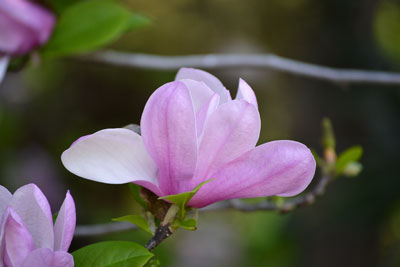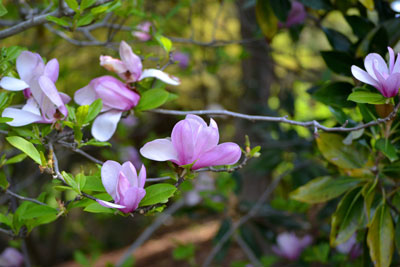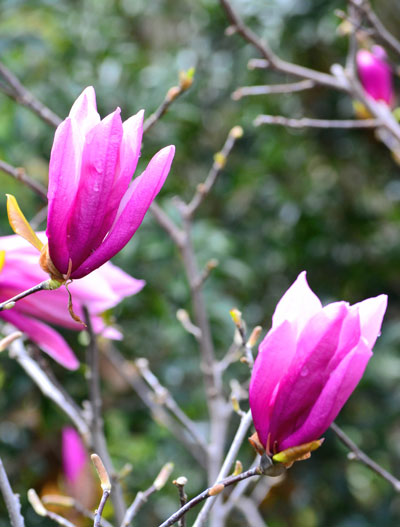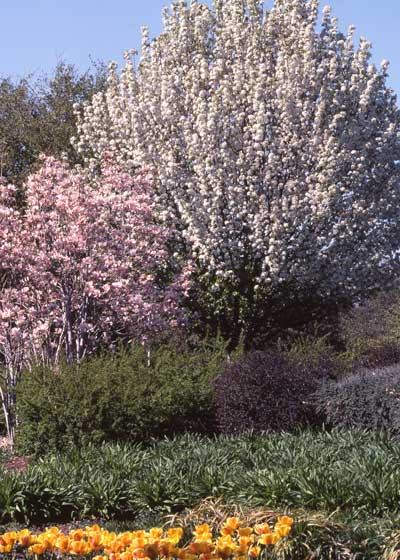Texas Tree Tips: April 2015

Photo by Bill Seaman
by Steve Houser
Tree Species Profiles—Top Rated
Ornamental Trees
Saucer Magnolia – Magnolia x soulangeana
Saucer magnolia, Magnolia x soulangeana, is a showstopper ornamental tree well worth consideration for your home landscape. It is not uncommon for someone to honk their horn at me for slowing down to enjoy one of these botanical beauties when they are in full bloom. I must confess that I am a rubberneckenpeepenlooker when it comes to cool trees.

Photo by Bill Seaman
Saucer magnolia is a deciduous ornamental tree that is a hybrid cross between Magnolia denudata and Magnolia liliflora by French plantsman Chevalier Soulange-Bodin in about 1820. Its large showy flowers, which open well before the foliage develops, made it highly desirable, and its adaptability to many weather and soil conditions only added to its popularity across the continents.

Photo by Bill Seaman
Depending on the cultivar, the saucer magnolia can grow to 25 feet or more in height, with a canopy that is typically round and low spreading. The canopy often becomes more irregular in shape as the tree ages. Saucer magnolias are long-lived trees, with a life expectancy that can exceed 100 years. They prefer loose, fertile soil, but they are very versatile and can grow in clay, loam, or sandy soils. They will not tolerate wet sites, and they are low to moderate in drought tolerance.
The leaves are an oval shape, 3 to 6 inches in length, and the leaf color varies according to the cultivar. Some are dull green and others are darker green. Fall color, when fickle Texas weather will allow it, can be bronze to gold. The bark is light grey in color and reasonably smooth. The twigs are reasonably stout, but the wood is medium in strength and I rate it as a “3 incher.” That’s the limb diameter needed to support my skinny body hanging from a tree climber’s rope.

A saucer magnolia (on the left) in full bloom beside a Bradford pear in Dallas. Photo by Neil Sperry.
Saucer magnolia blooms early in the spring unless there is a late frost or freeze after the flower buds start to emerge or after the tree is in bloom. They bloom best in full sun but will tolerate part shade. Flower shapes and colors can vary according to the cultivar, as does the time of spring that they flower. Some cultivars are pink and white, while others are purple and white or just all white. The blooms can vary in size, with most having a tulip shape.
Star magnolia, Magnolia stellata, is a similar but different magnolia species that can grow to 12 feet tall with white or pink blooms that are smaller and more daisy-like. While its stature is less than that of the saucer magnolia, and while its flower is smaller, star magnolias can hold their place in the garden.
The fruit, a cone-like structure, appears in August and can be 1 to 3 inches long. It contains small red or deep pink seeds that are attractive to birds and wildlife. This magnolia has no serious pathogen problems. Pest problems are typically minimal but may include scale, aphids, or spider mites. It seems there are always a few pests that want to bother trees — as well as humans, for that matter.
NOTE FROM NEIL: Saucer magnolias prefer acidic soils and may show iron deficiency in alkaline conditions. They are also best-suited to more humid areas of the eastern third or half of our state.

